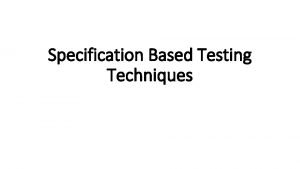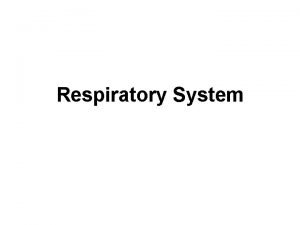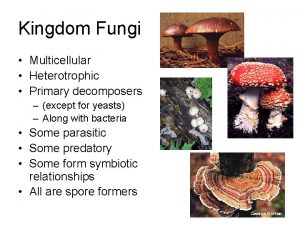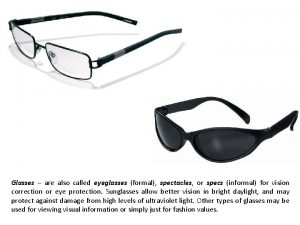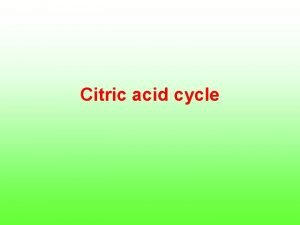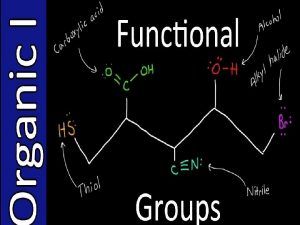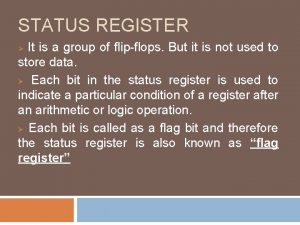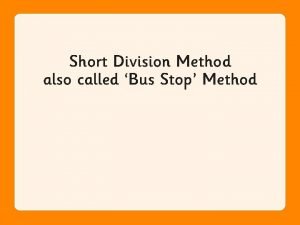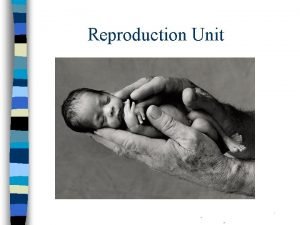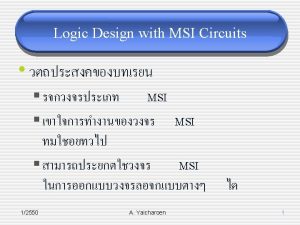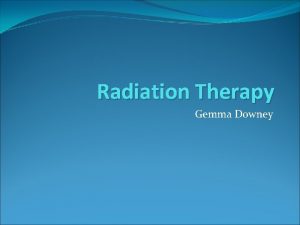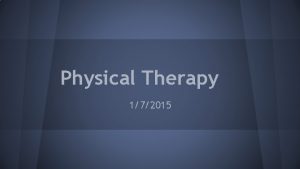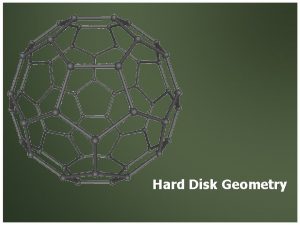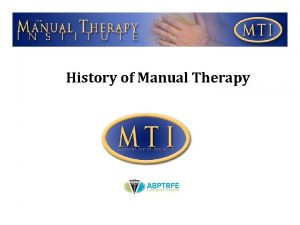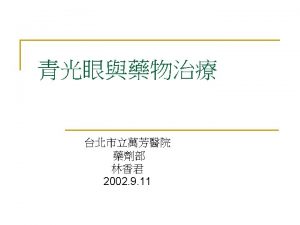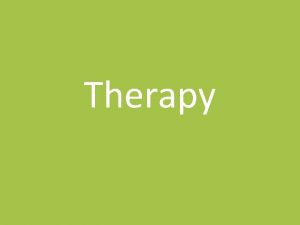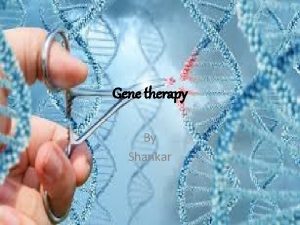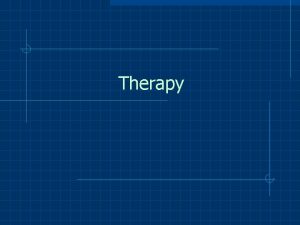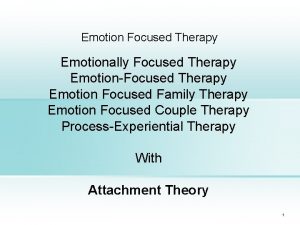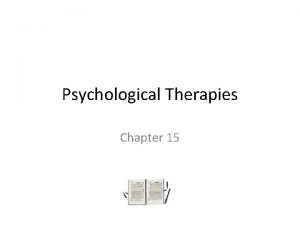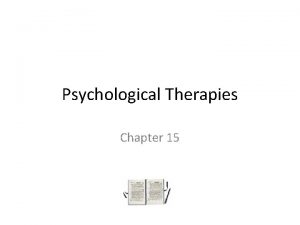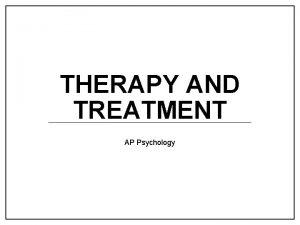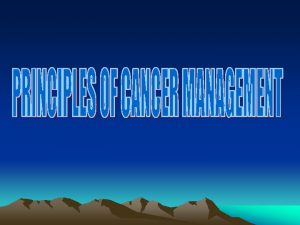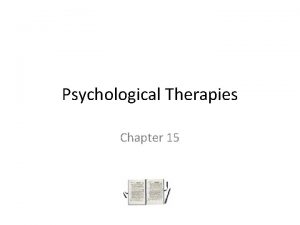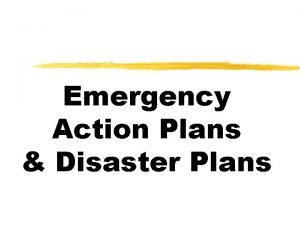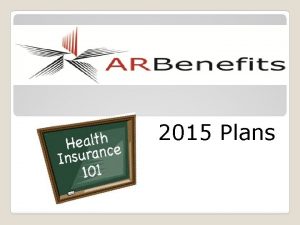PHYSICAL THERAPY TREATMENT PLANS ALSO CALLED The Physical




















- Slides: 20

PHYSICAL THERAPY TREATMENT PLANS ALSO CALLED The Physical Therapy Process

What is Physical Therapy? Field of medicine using physical agents and exercise to treat disabilities physical agents �heat, �Light �Water �Massage Exercise

Advocate Lutheran General Hospital Park Ridge, Illinois http: //www. advocatehealth. com/luth/se rvices/other/rehab/index. html

Physical Therapy Goals Relief of pain Post surgical Medical problems Muscle strength and mobility Improvement Basic function Improvement Standing Walking Grasping

Parts of The Physical Therapy Process 1. Assessment 1. The Examination 2. The Evaluation 2. 3. 4. 5. Diagnosis Prognosis Intervention/Treatment Re-Examination

3 Components of the Examination Patient/Client Medical History Systems Review Tests and measures

Examination: History/Current Health Status Medical Background Age Medications Cognitive status Medical History Etiology of injury or illness Event leading to problem Co-morbities (for example low back pain would be Arthritis, osteoporosis, lack of exercise, stress level, poor self rated health, dissatisfaction with work) Duration of problem Clinical Assessments Muscle Strength & ROM Reflex Assessment

Examination: Body systems • musculoskeletal • nervous • integumentary • Lymphatic & immune • Respiratory • Renal • Reproductive • Digestive • Circulation Systems Review

Examination: Tests and measures Body mechanics Gait Balance Orthotic devices Prosthetic requirements Range of motion Reflex integration Motor function

Assessment: Evaluation Analysis of: Examination results The environment for optimal human functioning �Beneficial environmental factors �Barriers to optimal functioning

Diagnosis Follows Examination & Evaluation Incorporates information from other medical team members Expressed in terms of movement dysfunction OR in Categories of impairments Activity limitations Participatory restrictions, Environmental influences Individual abilities/disabilities

Prognosis Determine the need for care/intervention Determine the desired improvement in function Determine amount of time to achieve that level Refer to another agency or health professional if treatment is not within the scope of physical therapy

Types of Intervention or Treatment Put into effect and modify to reach goals Manual handling Movement enhancement Physical, electro-therapeutic agents Functional training Provision of assistive technologies Patient related instruction and counseling

Intervention or Treatment continued Prevention of: Impairments Activity limitations Participatory restrictions Disability and injury

Intervention or Treatment continued Health promotion Maintenance of health Quality of life Workability and fitness

Treatment Plan continued Coordinate the Care Plan Health care team collaborates Family and Care giver roles

RE-Examination: DETERMINE THE OUTCOMES Progress of Care Identify how to measure outcomes Measure the outcomes to interventions Modify Care Plan in response to outcomes

Sample Treatment Plan

Activity: Assign students to groups and give them a case study: A baseball player has been wearing a long arm cast for 4 weeks following an injury to the distal humerus. Assessment of ROM following cast removal shows full extension of the elbow to be less than normal and painful. Design a treatment plan for the patient.

HS-TGM-5. Students will understand the importance of and demonstrate data collection as it relates to the goals, objectives, and implementation of the treatment plan according to their scope of practice. a. Observe, record, and report client behavior. b. Assist treatment team in observing, reporting, and recording client healthcare needs, strengths, and problems. c. Follow policies and protocols of the facility. d. Understand demonstrate all necessary interventions of the patient treatment plan as it relates to their scope of practice. e. Examine and demonstrate the importance of client collaboration and acceptance in identifying and implementing appropriate interventions in the treatment plan. f. Assist in identifying potential educational needs.
 Reality therapy treatment plan example
Reality therapy treatment plan example Psychodynamic and humanistic therapies have in common
Psychodynamic and humanistic therapies have in common Bioness bits cost
Bioness bits cost Psychoanalytic therapy is to as humanistic therapy is to
Psychoanalytic therapy is to as humanistic therapy is to Uninformed search algorithm
Uninformed search algorithm How is citric acid cycle regulated
How is citric acid cycle regulated Specifcation based techniques are also called as
Specifcation based techniques are also called as Pharynx
Pharynx A workbook is also called a
A workbook is also called a Primary decomposers
Primary decomposers Glasses also called eyeglasses (formal)
Glasses also called eyeglasses (formal) It is also called figurative language
It is also called figurative language Diphthongs are
Diphthongs are Citric acid cycle definition
Citric acid cycle definition Define axial movements
Define axial movements Alkanes are also called
Alkanes are also called Status register is also called as
Status register is also called as Division bus stop
Division bus stop Womb is also called
Womb is also called Raster scan display
Raster scan display Is also called as data selector.
Is also called as data selector.






